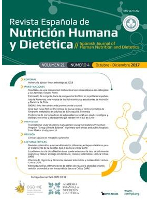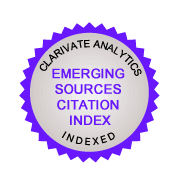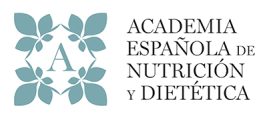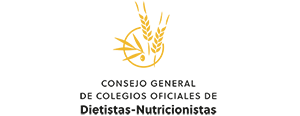Study of knowledge, attitudes and practices of complementary feeding among caregivers of children from 6 to 23 months of age from a rural community of Ecuador: A cross-sectional study.
DOI:
https://doi.org/10.14306/renhyd.28.4.2200Keywords:
Eating habits, nutritional status, Malnutrition, Children, Complementary feedingAbstract
Introduction. Nutritional deficiency due to an unbalanced diet is one of the most important factors contributing to stunting or the development of comorbidities in infants. Poverty, lack of knowledge about complementary feeding (CF) schedules, or lack of information accessibility are among the major causes that affect nutritional status. Our objective was to investigate the association of caregivers' knowledges, attitudes, and CF practices with the nutritional status of children aged 6 to 23 months attending the Camilo Ponce Enriquez Health Center from October to December 2022.
Methods: An observational study was conducted. Information from caregivers of 137 children aged from 6 to 23 months (mean age 12.66 ± 5.00, 51.82% female) was analyzed. The data collection process was carried out through the application of the KAP survey of the Food and Agriculture Organization of the United Nations (FAO), which first includes a socio-demographic survey consisting of 10 questions, 7 of which obtain information from the caregiver and 3 oriented to obtain data from the child. Informed consensus was obtained previous to the survey application. Information on the nutritional status was obtained from the medical history data provided by the nursing department. Pearson's Chi-squared test was applied to establish whether or not there was an association between the nutritional variables.
Results: 55.96% of caregivers had appropriate CF practices. Meanwhile, 77.89% and 77.55% had adequate knowledge and attitudes about CF. A statistically significant association (p < 0.05) was found between nutritional diagnosis and maternal CF knowledge, attitudes, and practices.
Conclusions: The knowledge, attitudes, and practices of the target population reached a moderate level, laying the foundation for the study of risk factors, as well as educational strategies to prevent malnutrition.
References
Lutter CK, Chaparro CM. Malnutrition in infants and young children in Latin America and the Caribbean: Achieving the Millennium Development Goal [Internet]. Washington (DC): The Pan American Health Organization; 2008 [cited 2024 Mar 14]. 203 p. Available from: https://iris.paho.org/bitstream/handle/10665.2/18641/9789275129289_eng.pdf?sequence=1&isAllowed=y
Kamudoni P, Kiige L, Ortenzi F, Beal T, Nordhagen S, Kirogo V, et al. Identifying and understanding barriers to optimal complementary feeding in Kenya. Matern Child Nutr 2024;20(S3). doi: 10.1111/mcn.13617.
United Nations International Children's Emergency Fund. Improving young children's diets during the complementary feeding period—UNICEF Programming Guidance [Internet]. New York: UNICEF Programming Guidance; 2020 Feb [Cited 2024 Mar 14]. 71 p. Available from https://www.unicef.org/documents/improving-young-childrens-diets-during-complementary-feeding-period-unicef-programming
Gulumser Sisko S, Bag O, Kondolot M, Nalbantoglu B, Gokcay G. Breastfeeding and infant nutrition knowledge, attitude, and practices of parents. Turk Arch Pediatr 2022;57(4):441-47. doi: 10.5152/TurkArchPediatr.2022.21201.
Chan K, Whitfield KC. High confidence, yet poor knowledge of infant feeding recommendations among adults in Nova Scotia, Canada. Matern Child Nutr 2020;16(2). doi: 10.1111/mcn.12903.
Allotey D, Flax VL, Ipadeola A, Kwasu S, Bentley ME, Worku B, et al. Maternal and paternal involvement in complementary feeding in Kaduna State, Nigeria: The continuum of gender roles in urban and rural settings. Matern Child Nutr 2022;18(2). doi: 10.1111/mcn.13325.
Jacquier EF, Angeles-Agdeppa I, Lenighan YM, Toledo MB, Capanzana MV. Complementary feeding patterns of Filipino infants and toddlers lack diversity, especially among children from poor households. BMC Nutr 2020;6(1):51-60. doi: 10.1186/s40795-020-00376-1.
World Health Organization. Malnutrition [Internet]. 2024 March 1 [cited 2024 Feb 11]. Available from: https://www.who.int/es/news-room/fact-sheets/detail/malnutrition
World Health Organization; United Nations Children’s Fund. Indicators for assessing infant and young child feeding practices: definitions and measurement methods [Internet]. 2021 [cited 2024 Mar 13]. Available from: https://iris.who.int/bitstream/handle/10665/340706/9789240018389-eng.pdf?sequence=1
Shivakumar N. Encyclopedia of Human Nutrition [Internet]. 4th ed. 2023 Mar. Chapter 4, Complementary Feeding; [cited 2024 Mar 14]; p. 43–9. Available from: https://www.sciencedirect.com/science/article/abs/pii/B9780128218488000184
Berhanu Z, Alemu T, Argaw D. Predictors of inappropriate complementary feeding practice among children aged 6 to 23 months in Wonago District, South Ethiopia, 2017; case control study. BMC Pediatr 2019;19(1):146-59. doi: 10.1186/s12887-019-1523-6.
Harrison L, Padhani Z, Salam R, Oh C, Rahim K, Maqsood M, et al. Dietary strategies for complementary feeding between 6 and 24 months of age: The evidence. Nutrients 2023;15(13):3041-66. doi: 10.3390/nu15133041.
Schwartz C, Scholtens PA, Lalanne A, Weenen H, Nicklaus S. Development of healthy eating habits early in life. Review of recent evidence and selected guidelines. Appetite 2011;57(3):796–807. doi: 10.1016/j.appet.2011.05.316.
Bouchard KL, Grigsby-Toussaint DS, Fox K, Amin S, Vadiveloo M, Greaney ML, et al. Maternal experiences with discussing complementary feeding in primary care. Int J Environ Res Public Health 2022;19(19):12061-76. doi: 10.3390/ijerph191912061.
Wormald N, Oyanader B, Piñuñuri R, Valenzuela C. Características de la alimentación temprana y actual de preescolares en la Región de Valparaíso, Chile. Rev. Chil. Nutr. 2021;48(3): 366-373. http://dx.doi.org/10.4067/s0717-75182021000300366.
Mayen AL, Marques-Vidal P, Paccaud F, Bovet P, Stringhini S. Socioeconomic determinants of dietary patterns in low- and middle-income countries: a systematic review. Am J Clin Nutr 2014;100(6):1520–31. doi: 10.3945/ajcn.114.089029.
Shrestha S, Pokhrel M, Mathema S. Knowledge, attitude and practices among mothers of children 6 to 24 months of age regarding complementary feeding. JNMA J Nepal Med Assoc 2020;58(230):758-63. doi: 10.31729/jnma.5274.
Gizaw AT, Sopory P, Sudhakar M. Determinants of knowledge, attitude and self-efficacy towards complementary feeding among rural mothers: Baseline data of a cluster-randomized control trial in South West Ethiopia. PLoS One 2023;18(11):e0293267. doi: 10.1371/journal.pone.0293267.
Yadav KK, Awasthi S. Childhood pneumonia: what’s unchanged, and what’s new? Indian J. Pediatr 2023;90(7):693–99. doi: 10.1007/s12098-023-04628-3.
Dipasquale V, Romano C. Complementary feeding: new styles versus old myths. Minerva Med 2020;111(2):141-52. doi: 10.23736/S0026-4806.19.06320-1.
Campoy C, Campos D, Cerdo T, Dieguez E, Garcia-Santos JA. Complementary feeding in developed countries: The 3 Ws (When, What, and Why?). Ann Nutr Metab 2018;73(1):27-36. doi: 10.1159/000490086.
Huiracocha-Tutiven L, Orellana-Paucar A, Abril-Ulloa V, Huiracocha-Tutiven M, Palacios-Santana G, Blume S. Child Development and Nutritional Status in Ecuador. Glob Pediatr Health. 2019;6:2333794X18821946. doi: 10.1177/2333794X18821946.
Boswell N. Complementary feeding methods—A review of the benefits and risks. Int. J. Environ. Res. Public Health 2021;18(13):7165-80. doi: 10.3390/ijerph18137165.
Instituto Nacional de Estadísticas y Censos. Población y demografía [Internet]. Quito (EC); 2024. [Cited 2024 Jul 3]. Available from: https://www.ecuadorencifras.gob.ec/censo-de-poblacion-y-vivienda/
Fautsch Y, Glasauer P. Guidelines for assessing nutrition-related knowledge, attitudes and practices. Food and Agriculture Organization of the United Nations. Rome. 2014
Sokhela H, Govender L, Siwela M. Complementary feeding practices and childhood malnutrition in South Africa: The potential of moringa oleifera leaf powder as a fortificant: A narrative review. Nutrients 2023;15(8):2011-17. doi: 10.3390/nu15082011
Bailey RL, Stang JS, Davis TA, Naimi TS, Schneeman BO, Dewey KG, et al. Dietary and complementary feeding practices of US infants, 6 to 12 months: A narrative review of the federal nutrition monitoring data. J Acad Nutr Diet 2022;122(12):2337–45. doi: 10.1016/j.jand.2021.10.017.
Klerks M, Roman S, Bernal MJ, Haro-Vicente JF, Sanchez-Siles LM. Complementary feeding practices and parental pressure to eat among Spanish infants and toddlers: A cross-sectional study. Int J Environ Res Public Health 2021;18(4):1982-99. doi: 10.3390/ijerph18041982.
Cavalcanti AU, Boccolini CS. Desigualdades sociais e alimentaçao complementar na América Latina e no Caribe. Cien Saude Colet. 2022;27(2):619–30. doi: 10.1590/1413-81232022272.31862020
Spipp J, Riernersman C, Rivas F, Calandri E, Albrecht C. Assessment of dietary intakes and feeding practices in children aged 6–23 months in a town in the Northeast region of Argentina. Arch Argent Pediatr. 2022;120(6):369-76. doi: 10.5546/aap.2022.eng.369
Castillo E, Chuman A, Diaz C. Maternal practices in complementary feeding of infants living in anemia’s prevalent areas in northern Peru. Rev Cubana Pediatr. 2022; 94(2):e1956.
Madero K, Ruidiaz K, Rivera J, López DM. Application of key practices: breastfeeding, complementary feeding, micronutrients, mental and social development of children under 5 years of age. Arch. Med. (Manizales). 2020;21(1):92–106. doi: 10.30554/archmed.21.1.3876.2021
Kumar S, Jha SK, Singh A, Rawat CM, Awasthi S, Bano M, et al. Knowledge, attitude and practices (KAP) regarding breastfeeding: A community based cross sectional study from rural Uttrakhand. Healthline 2015;6(2):17–22.
Kumar R, Mundhra R. A cross-sectional study of knowledge, attitude, and practice toward breastfeeding among postnatal mothers delivering at a tertiary care center in Garhwal, India. Int J Appl Basic Med Res 2021;11(2): 64-69. doi: 10.4103/ijabmr.IJABMR_605_20.
Bimpong KA, Cheyuo EK, Abdul-Mumin A, Ayanore MA, Kubuga CK, Mogre V. Mothers' knowledge and attitudes regarding child feeding recommendations, complementary feeding practices and determinants of adequate diet. BMC Nutr 2020;6(1):67-75. doi: 10.1186/s40795-020-00393-0.
Ministry of Economic and Social Inclusion. More opportunities for Children with a Future: On Children's Day, Lasso presented the 1000 Days Bonus [Internet]. Riobamba. 2022 Jun 1 [cited 2023 Apr 22]. Available from: https://www.inclusion.gob.ec/mas-oportunidades-para-una-infancia-con-futuro-en-el-dia-de-la-ninez-lasso-presento-el-bono-de-los-1000-dias/
United Nations. Together we go further: the UN in Ecuador, working against chronic child malnutrition [Internet]. 2022 Dec 23 [cited 2023 Mar 9]. Available from: https://ecuador.un.org/es/213134-juntos-llegamos-m%C3%A1s-lejos-la-onu-en-ecuador-trabajando-contra-la-desnutrici%C3%B3n-cr%C3%B3nica
Downloads
Published
How to Cite
Issue
Section
License
Copyright (c) 2020 Rocío Lara, Katherine García, Luz Valencia, Alfonso Silva

This work is licensed under a Creative Commons Attribution-NonCommercial-ShareAlike 4.0 International License.











